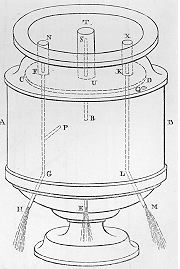If there be a vessel vessel containing wine, and provided with three spouts, wine shall flow through the middle of the three; and, when water is poured in, the stream of wine shall cease, and water shall flow through the other two; again, when the stream of water ceases, wine shall flow through the middle spout: and this shall take place as often as we pour in water.
 Let A B (fig. 39), be a vessel the neck of which is
closed by the partition C D, and having a spout, E, at the bottom. Let
two tubes, F G H, K L M, terminating in spouts, pass through the
partition and project above it; and round the projecting parts place
other tubes, N, X, covered with lids at the top and extending to the
partition except a passage for the water. Another tube, P, reaching
nearly up to the partition, communicates with F G H. Having first closed
the spout E, fill the vessel A B with wine through an orifice, Q, which
must be carefully closed afterwards. When E is set free it will be
found that wine flows through it, for air enters from without into the
void created, through the orifice H and the tube P. Now, if we pour
water upon the partition C D, it will be carried out through the tubes F
G H, K L H; but, as the air has no means of entering the vessel, A B,
the wine will cease to flow until all the water has escaped, when the
air finds an entrance again and the wine flows. Instead of the tube P,
another tube, R S, may be used, piercing through the partition, about
which another, T U, must lie, like the tubes N and X, but higher than
those, so that R S may rise above the lip of the vessel. The same result
will follow.
Let A B (fig. 39), be a vessel the neck of which is
closed by the partition C D, and having a spout, E, at the bottom. Let
two tubes, F G H, K L M, terminating in spouts, pass through the
partition and project above it; and round the projecting parts place
other tubes, N, X, covered with lids at the top and extending to the
partition except a passage for the water. Another tube, P, reaching
nearly up to the partition, communicates with F G H. Having first closed
the spout E, fill the vessel A B with wine through an orifice, Q, which
must be carefully closed afterwards. When E is set free it will be
found that wine flows through it, for air enters from without into the
void created, through the orifice H and the tube P. Now, if we pour
water upon the partition C D, it will be carried out through the tubes F
G H, K L H; but, as the air has no means of entering the vessel, A B,
the wine will cease to flow until all the water has escaped, when the
air finds an entrance again and the wine flows. Instead of the tube P,
another tube, R S, may be used, piercing through the partition, about
which another, T U, must lie, like the tubes N and X, but higher than
those, so that R S may rise above the lip of the vessel. The same result
will follow.